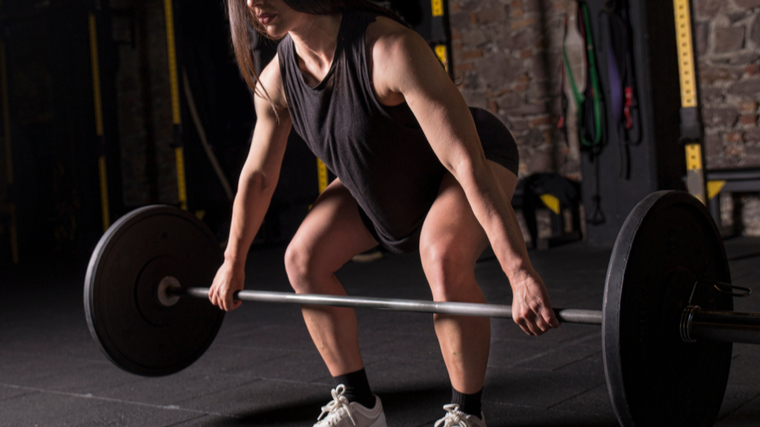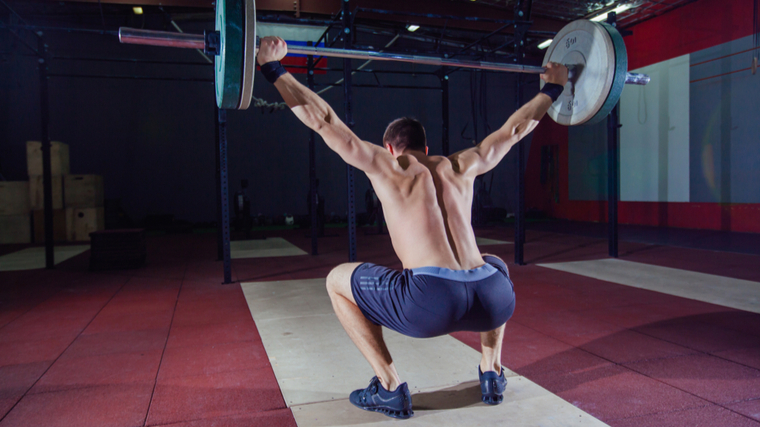Training is a series of choices. There is a broad range of unique bars, grip orientations, and exercises that you can use to get respectably strong. Some choices allow you to make certain gains by preference — such as overhand or underhand grip on your barbell row. On the other hand, some choices are mandatory, like choosing an Olympic barbell for its spin.
Sometimes, like in the case of the snatch grip, these factors overlap. The snatch grip is absolutely necessary when you perform the Olympic lift of the same name, but also comes with plenty of customizability and carryover to other nooks and crannies of your workout routine.

Class is in session. This is snatch grip 101.
Snatch Grip 101
- What Is the Snatch Grip?
- How to Do the Snatch Grip
- Benefits of the Snatch Grip
- Factors to Consider
- Snatch Grip Tips
What Is the Snatch Grip?
The snatch is a barbell exercise whereby, in one clean motion, you take the barbell from the ground in a deadlift(ish) position to standing with the bar locked out over your head. Sounds complicated, doesn’t it? The snatch benefits from (and basically requires) a specific grip placement. Like many power or strength exercises, small changes in your setup make an enormous impact on the success of the lift. It’s at this stage that the value of the snatch grip begins to take shape.
Every weightlifter will have a different snatch grip due to their natural proportions. Taller athletes with longer arms will generally need to grip the bar closer to the collars in order to make hip contact, which is essential for performing the snatch well. Such a wide grip comes with a host of factors to consider but, accordingly, also provides plenty of unique benefits to everything from shoulder stability to hypertrophy.
How to Do the Snatch Grip
To perform the snatch grip, grab an empty barbell or PVC pipe and stand fully erect. Hinge at the hips and “pinch” the barbell in your hip crease to hold it in place. Then, reach your arms out to the side and grip the bar with your elbows locked. Release it from your hips and stand back up again. The bar should rest comfortably against your hips, right above the groin, while your arms are straight. That’s your snatch grip.
In order to best secure the bar in your hand, you’ll need to take either a double-overhand grip, or better yet, a hook grip. In any case, you will not be able to grab the bar with a mixed grip as the width of your arms would make that position virtually impossible.
Benefits of the Snatch Grip
At a glance, it may be a bit hard to believe that a small adjustment like hand placement can significantly change your experience with an exercise. That said, the snatch grip brings with it plenty of unique benefits for the veteran weightlifter and first-day gymgoer alike.
Improved Grip Strength
While it is obvious, it’s worth mentioning. The wider you grip a barbell, the harder that bar is to hold onto because it sits in your palm at an angle. The muscles in your forearm thus have to work much harder to keep your fingers clasped tightly around the shaft of the bar. Working with a snatch grip on any kind of deadlift, or even an overhead carry, is a great way to build up strong and powerful hands.
More Range of Motion
In a powerlifting deadlift, you typically want your grip to facilitate perfectly vertical arms so the barbell is as low to the ground as possible. Conversely, the snatch grip dramatically increases your range of motion. When setting up to deadlift, you’ll have to sink your legs lower than you normally would.
During a Romanian deadlift, you have to hinge deeper for the barbell to reach your knees, since it rests higher by default. The snatch grip is a convenient mechanism for sneaking in some extra range of motion without adjusting your overall technique.
Convenient Variation
Varying your movements allows you to keep your training both fun and effective. However, you may not always want to swap out exercises altogether if you broadly enjoy them. Fortunately, working with a snatch grip allows you to bring some novelty into the picture without having to re-learn a different exercise altogether.
A snatch-grip deadlift will feel very different and work your lower body a bit distinctly from your standard pull. All it takes to change things up is adjusting your hand position.
Factors To Consider When Using a Snatch Grip
The snatch grip is both a great way to enhance or alter your general training and is a mandatory prerequisite to Olympic lifting itself. How, when, and where you utilize it comes down to knowing your own limitations and goals as an athlete.
Grip Strength
Grip strength is something that a snatch grip can help develop for the snatch exercise itself but also any exercise that requires a firm squeeze. By virtue of being a wide hand placement, the most common grip failure point (the pinky and ring fingers) are placed at a more disadvantageous position.
While this will ultimately put a lid on how much load you can work with, the snatch grip can serve as an excellent complement to other forms of training if your grip limits your workouts overall.
Application To Sport
The snatch grip is an essential component of the snatch exercise itself. The sport of Olympic lifting involves achieving the highest total accumulated weight between the clean & jerk and the snatch — without a solid snatch grip you’re going to be pretty disappointed in your performance on or off the platform.
In addition to Olympic lifting, the snatch grip also has some relevance in powerlifting. By applying a snatch grip to your deadlift, you will have to reduce the load on the bar. From here, you can build an iron grip, keep the deadlift technique in your program, and allow your body some much needed time to recover from working with ultra-heavy weights.
Application To Training
Applying the snatch grip to your workout routine is a fantastic way to autoregulate your training, especially in the deadlift. When you weave some snatch-grip work into your sessions, you’re going to highlight the weakest points that could be a hindrance the next time you go to test your 1-rep max.
The wider hand placement puts your upper back muscles in a less advantageous position for numerous exercises, meaning that they will need to work harder to maintain their position even with lighter weights. Using a snatch grip is a brilliant way to fill in potential gaps that could lead to a plateau in training or competition.
Wide(r) vs. Narrow(er) — Pros & Cons
Once you’ve determined a baseline snatch grip width, there are some pros and cons of slightly adjusting wider or more narrow. This is a decision that impacts the degree of difficulty and, in some cases, the benefits you’ll receive from using the grip.
Wider Grip
By assuming a slightly wider than normal grip, you’ll naturally find your torso more pitched over. It can also further reduce the range of motion you’ll need to throw the bar through during the snatch exercise itself.
However, with a wider grip you will also likely have a weaker grasp in general. This is perfect if the intent is to specifically strengthen it but can be a limiting factor otherwise.
Narrower Grip
You’ll probably find a narrower snatch grip to be a bit more comfortable and stable. Furthermore, while it will mean a higher degree of mobility is required of your shoulders, a snatch held overhead with a “close” (relatively) grip should feel more secure and stable.
With that in mind, however, a closer grip also means a larger bar path in the snatch since the bar itself must travel higher.
Snatch Grip Tips
Improving the snatch grip can be achieved by working up the courage to implement a hook grip, maintaining your overall shoulder function and, ultimately, logging more practice on the gym floor.
Develop Your Hook Grip
A good hook grip goes hand-in-hand, literally, with most snatch-grip exercises. Hooking your grip may reduce some of the forearm stimulation you’d normally get from grabbing the bar wide, but the trade-off is ensuring the bar always stays snug in your hand.
Instead of the thumb being wrapped around the bar normally, you’ll place it between the bar and your four other fingers like a door jam. This will allow the bar to rotate freely in your palm during Olympic lifting and is by far the most secure grips available.
Maintain Shoulder Mobility
When you grab a bar with a snatch grip, your shoulder goes deep into internal rotation. However, if you were to take the barbell overhead with the same grip, your scapula must rotate accordingly and translate to a fixed and extended position under load.

To ensure this process flows smoothly and painlessly, you need to maintain proper shoulder function. Healthy and stable shoulders separate an uncomfortable snatch grip from one that feels like home.
Practice
Ultimately, getting better at anything comes down to putting in the sets and repetitions. A true hallmark of all forms of training is the consistency with which you program it. In order to best improve your snatch grip, keep it in your program so that you can accumulate more sets and repetitions to refine the skill and strength that it requires.
Get a Grip
Widening your hands may not seem like much, but for a barbell exercise such as a deadlift, the snatch grip can immediately make a big impact on the feel of the exercise, the difficulty of it, and the benefits it affords you. Sometimes it’s difficult to switch up your workouts or introduce a new style of lifting without derailing all your focus and diligence in the gym.
Luckily, the snatch grip allows you to do a lot with a little. Whether you’re a dedicated weightlifter or an average Joe looking for a new way to tackle your workouts, the snatch grip belongs in your repertoire.
Featured Image: Berkomaster / Shutterstockq
The post Snatch Grip 101: How to Build Beefier Forearms and a Stronger Pull At the Same Time appeared first on BarBend.

